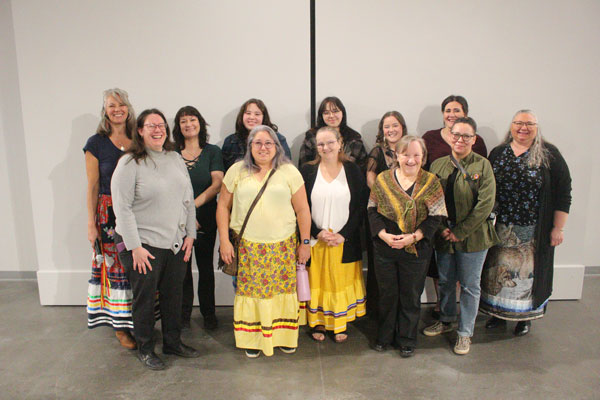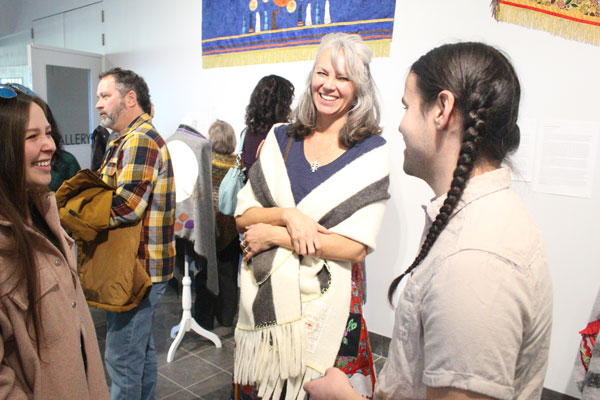
The Moon Shawl is an important symbol for a Métis woman, and that was the purpose behind the latest Mann Art Gallery exhibit.
The gallery held an opening reception for The Moon is Our Grandmother: 13 Métis Moon Shawls on Saturday. Thirteen Métis women created 13 Moon Shawls under the artistic direction of Leah Dorion and Bonny Johnson this summer, with support from Elder Elsie Sanderson.
Each shawl represents one of the 13 moons in the lunar year, rich with personal and cultural symbolism.
“Métis women get to tell their stories by making a piece of wearable art that tells their story in a creative and cultural way,” Johnson explained.
The show is curated by Dorion, Johnson and interim Mann curator Lana Wilson.
Johnson said Moon Shawls came from traditional times when women would go on moon times to moon lodges.
“It was a specific place where women would go and there would be Elders there,” she explained. “It was a time of prayer and meditation. Our families were taken care of by the other people and we would use our shells in that prayerful time.”
Moon lodges no longer exist, but Johnson said the concept is still around.
“Now we use our moon shawls in ceremonies, specifically moon ceremonies, because there’s a moon ceremony every single full moon of the year,” she explained.

Johnson said that there are three or four Moon Ceremonies that take place around Prince Albert. During colonization, ceremonial acts were banned and the Moon Ceremonies went underground. When the ceremonies returned, women remained left behind.
“Women remain under more of a patriarchal kind of situation,” Johnson said. “Now it’s like we’re able to give an opportunity for women to take their rightful place to use their voices and tell their stories.”
Dorion previously created an art show called The 13 Moons under the guidance of her aunt Elsie Sanderson, who could not attend the opening but was there in spirit, she said.
“She wanted to be here,” Dorion said. “I actually worked with her prior and did a whole art show. I used my creative style to tell the story of the 13 moons from that unique point of view that I have. I just wanted to bring awareness that there’s a whole knowledge system that it is inherent.”
Johnson said this project was different because Dorion’s project was based on Sanderson’s specific teachings.
Johnson explained that each moon shawl is the artist’s expression to their relationship to each moon.
The project lasted for the majority of the summer to complete.
“It took about six weeks, more for some people who had to finish the beadwork, so it was very beautiful,” Dorion said.

Wilson explained that the Mann has been home to a cultural sewing residency for about five years.
“Leah and Bonnie had told me that they had made a moon shawl and so we hosted a weekend workshop where we sewed moon shawls,” Wilson said.
“It was interesting because at that time Leah told me that she and Bonnie were really invested in helping to fill a need for Métis women to wear cultural clothing both in ceremonial and in public spaces and talking to me about how the ruffled skirt was filling that need,” Wilson said.
She explained that Dorion and Johnson said that there are three pieces of clothing including the ruffled skirt and moon shawl.
“That’s why they said to me that it would be really good to do a shawl workshop and that that we already had experimented doing a workshop for it,” Wilson said.
That model was also used for the previous show Love in Every Stitch: Métis Ribbon Skirts from Kistapinanihk project and Dorion said that the model of holding workshops really works well.
“I saw every artist go further with their creativity and learn new mediums, and for me that was such a fantastic way to watch artists grow,” Dorion said. “They’re technical and they’re storytelling.”
“They would try and they would be frustrated because it’s not working,” Johnson added. “It goes back to all of those old kinds of traditional things that we do when women get together and sew. We form a community that we support each other.”
The sewing also acts as a way to bond for the women taking part.
“Within that circle though, you can be frustrated and you can be ready to give up, but. you’re being held up,” Johnson said.
“Though someone maybe has produced something that they think is like a lower level work, when you look, you don’t know which women out there thought that their project was no good, but they just kept trying.”
Wilson explained that some of the work was done by people who were sewing or doing embroidery and beadwork for the very first time.
The 13 Moon Shawls include Beverly Boe for January, Johnson for February, Christfore Tienkamp for March, Ashley Jewitt for April, Abigail Sinclair for May, Harmony Johnson-Harder for June, Dorion for July, Olivia Fetch for August, Connie Sanche for September, Nicole Parenteau for October, Sharie Bird for November, Isabella Sinclair for December and the 13th Moon by Prisca Bravo.
This project’s major sponsors include SaskCulture and Saskatchewan Lotteries, through the Aboriginal Art & Culture Leadership Grant (AACL).
The exhibition is open at the Mann Art Gallery until Jan. 20, 2024.
michael.oleksyn@paherald.sk.ca

